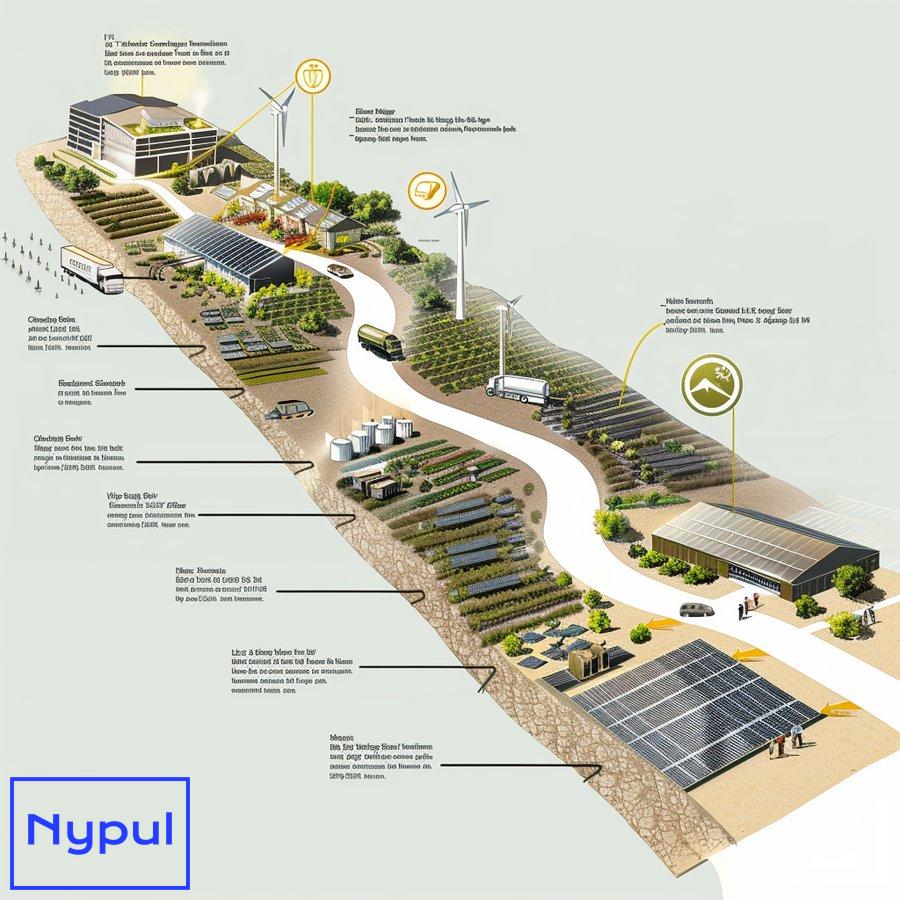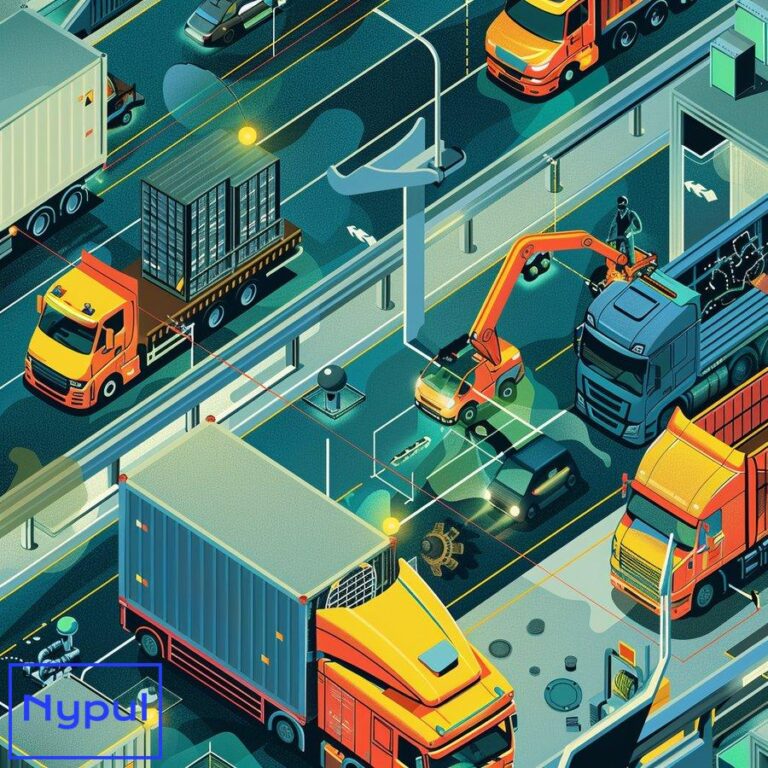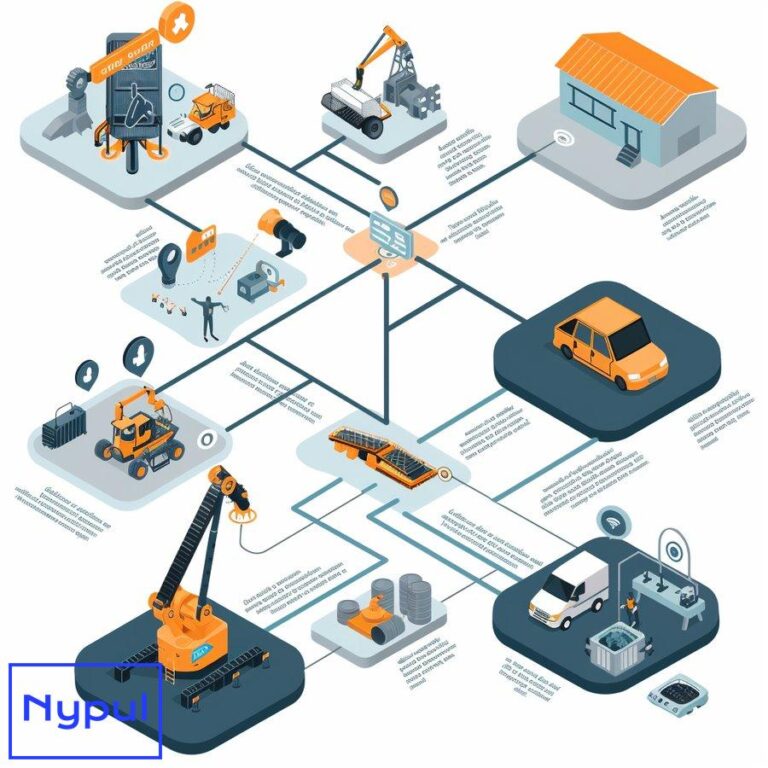What Is Solar Energy Integration
Solar energy integration refers to the process of incorporating solar power generation into existing electrical grids and energy systems. This complex endeavor involves seamlessly blending solar-generated electricity with traditional power sources to create a reliable, efficient, and sustainable energy infrastructure.
The concept of solar energy integration encompasses various technical, economic, and regulatory aspects. At its core, it aims to maximize the utilization of solar power while maintaining grid stability and reliability. This process requires careful planning, advanced technologies, and coordinated efforts from multiple stakeholders.
Solar energy integration can occur at different scales:
Residential Integration: Individual homeowners install rooftop solar panels and connect them to the local grid.
Commercial Integration: Businesses and organizations implement solar systems to offset their energy consumption and potentially feed excess power back to the grid.
Utility-Scale Integration: Large solar farms are connected directly to the transmission grid, providing substantial amounts of renewable energy to the power system.
The integration process involves several key components:
Solar Panels: These photovoltaic devices convert sunlight into electricity.
Inverters: They transform the direct current (DC) produced by solar panels into alternating current (AC) used by the grid.
Energy Storage Systems: Batteries or other storage technologies help manage the intermittent nature of solar power.
Smart Grid Technologies: Advanced metering, communication, and control systems enable efficient management of solar energy within the grid.
Grid Infrastructure: Transmission and distribution networks must be adapted to accommodate bidirectional power flows.
Successful solar energy integration requires addressing various challenges:
Intermittency: Solar power generation varies with weather conditions and time of day.
Grid Stability: Large amounts of variable solar power can impact voltage and frequency regulation.
Energy Storage: Effective storage solutions are needed to balance supply and demand.
Grid Capacity: Existing infrastructure may need upgrades to handle increased distributed generation.
Regulatory Framework: Policies and regulations must evolve to support solar integration.
As solar technology advances and costs decrease, the importance of effective integration grows. It plays a crucial role in achieving renewable energy targets, reducing carbon emissions, and creating a more resilient and sustainable energy system.
Solar energy integration represents a significant shift in how we generate, distribute, and consume electricity. It offers numerous benefits, including reduced reliance on fossil fuels, lower electricity costs, and increased energy independence. However, it also presents technical and economic challenges that require innovative solutions and collaborative efforts across the energy sector.
How do the components of a solar energy system work together?
A solar energy system comprises several interconnected components that work in harmony to capture sunlight, convert it into usable electricity, and integrate it with the existing power grid. Understanding how these components interact is crucial for effective solar energy integration.
Solar Panels
Solar panels, also known as photovoltaic (PV) modules, form the foundation of any solar energy system. These panels consist of multiple solar cells made from semiconductor materials, typically silicon. When sunlight strikes these cells, it initiates the photovoltaic effect:
- Photons from sunlight excite electrons in the semiconductor material.
- The excited electrons flow through the material, generating direct current (DC) electricity.
- The amount of electricity produced depends on factors such as sunlight intensity, panel efficiency, and temperature.
Inverters
Inverters play a critical role in solar energy systems by converting the DC electricity generated by solar panels into alternating current (AC) used by household appliances and the power grid. There are two main types of inverters:
String Inverters: These connect multiple solar panels in a series (string) and convert their combined DC output to AC.
Microinverters: Installed on each individual solar panel, these convert DC to AC at the panel level, offering better performance in partially shaded conditions.
Inverters also perform other essential functions:
- Monitoring system performance and energy production
- Providing data for system owners and utilities
- Implementing safety features like rapid shutdown in case of emergencies
Energy Storage Systems
Energy storage systems, typically in the form of batteries, address the intermittent nature of solar power generation. They store excess energy produced during peak sunlight hours for use when solar production is low or during power outages. Key functions include:
- Storing surplus solar energy for later use
- Providing power during grid outages (backup power)
- Enabling load shifting to reduce peak demand charges
- Smoothing out fluctuations in solar power output
Charge Controllers
In systems with battery storage, charge controllers regulate the flow of electricity between solar panels and batteries. They prevent overcharging and extend battery life by:
- Monitoring battery voltage and state of charge
- Adjusting charging rates based on battery conditions
- Disconnecting the solar array when batteries are fully charged
Monitoring Systems
Monitoring systems provide real-time data on system performance, energy production, and consumption. They typically include:
- Software interfaces for system owners to track performance
- Communication devices to transmit data to monitoring platforms
- Sensors to measure various system parameters
Grid Connection Equipment
For grid-tied systems, additional components ensure safe and compliant connection to the utility grid:
- Disconnect switches for safety during maintenance or emergencies
- Meters to measure energy flow between the solar system and the grid
- Grid-tie inverters with anti-islanding protection to prevent backfeeding during outages
System Integration
The seamless integration of these components is crucial for optimal system performance:
- Solar panels capture sunlight and generate DC electricity.
- Inverters convert DC to AC and synchronize with the grid frequency.
- Energy storage systems store excess power and provide it when needed.
- Charge controllers manage battery charging and discharging.
- Monitoring systems track performance and alert owners to any issues.
- Grid connection equipment ensures safe interaction with the utility grid.
This integrated approach allows solar energy systems to efficiently generate, store, and distribute clean electricity while maintaining grid stability and reliability.
| Component | Primary Function | Interaction with Other Components |
|---|---|---|
| Solar Panels | Generate DC electricity from sunlight | Provide power to inverters and charge controllers |
| Inverters | Convert DC to AC, synchronize with grid | Receive power from panels, send AC to home/grid |
| Energy Storage | Store excess energy, provide backup power | Interact with charge controllers and inverters |
| Charge Controllers | Regulate battery charging | Manage power flow between panels and batteries |
| Monitoring Systems | Track system performance | Collect data from all components |
| Grid Connection Equipment | Ensure safe grid integration | Interface between solar system and utility grid |
Understanding the interplay between these components is essential for designing efficient and reliable solar energy systems. As technology advances, the integration of these components becomes increasingly sophisticated, leading to more effective solar energy integration at all scales.
Why is grid integration challenging for solar energy?
Grid integration of solar energy presents several significant challenges due to the unique characteristics of solar power generation and its impact on traditional power systems. These challenges stem from technical, economic, and regulatory factors that must be addressed to ensure reliable and efficient integration of solar energy into existing grids.
Intermittency and Variability

Solar power generation is inherently intermittent and variable, depending on factors such as:
- Time of day
- Weather conditions
- Seasonal changes
This variability can lead to:
- Rapid fluctuations in power output
- Mismatches between supply and demand
- Difficulties in accurate power forecasting
Grid operators must constantly balance supply and demand to maintain system stability. The unpredictable nature of solar generation complicates this task, requiring more sophisticated forecasting tools and flexible backup generation capacity.
Reverse Power Flow
Traditional power grids were designed for unidirectional power flow from centralized generation plants to consumers. Solar energy integration introduces bidirectional power flow, particularly in areas with high penetration of distributed solar systems. This can lead to:
- Voltage regulation issues
- Potential equipment overloading
- Challenges in protection system coordination
Grid infrastructure and control systems need to be upgraded to handle these bidirectional flows effectively.
Voltage and Frequency Regulation
Large-scale solar integration can impact grid voltage and frequency stability:
- Voltage fluctuations due to varying solar output
- Reduced system inertia, affecting frequency stability
- Potential for voltage rise in distribution networks
Advanced inverter technologies and grid control systems are necessary to mitigate these issues and maintain power quality.
Ramp Rates and Duck Curve
The “duck curve” phenomenon, observed in areas with high solar penetration, presents operational challenges:
- Steep ramps in net load during sunset hours
- Potential overgeneration during midday
- Need for flexible generation to meet evening peak demand
This requires careful planning and deployment of flexible resources to manage these rapid changes in net load.
Grid Capacity and Infrastructure
Existing grid infrastructure may not be designed to accommodate high levels of solar integration:
- Potential congestion in transmission and distribution networks
- Need for grid reinforcement and expansion
- Challenges in optimal siting of large-scale solar projects
Significant investments in grid infrastructure upgrades are often necessary to support increased solar capacity.
Energy Storage Integration
While energy storage can address many integration challenges, it introduces its own complexities:
- High costs of large-scale storage systems
- Optimal sizing and siting of storage facilities
- Integration of storage control systems with grid operations
Effective integration of energy storage requires careful planning and coordination with other grid resources.
Market and Economic Challenges
Solar integration impacts traditional electricity markets and utility business models:
- Reduced revenues for conventional generators
- Need for new market mechanisms to value flexibility and ancillary services
- Challenges in cost allocation for grid upgrades
Market reforms and new business models are necessary to align economic incentives with the needs of a solar-integrated grid.
Regulatory and Policy Frameworks
Existing regulatory structures may not adequately support high levels of solar integration:
- Need for updated interconnection standards
- Challenges in net metering policies and rate structures
- Balancing incentives for solar adoption with grid stability concerns
Regulatory reforms are crucial to create a supportive environment for solar integration while ensuring grid reliability and fairness for all stakeholders.
Cybersecurity and Resilience
Increased reliance on digital technologies for solar integration raises cybersecurity concerns:
- Potential vulnerabilities in smart inverters and control systems
- Need for robust data protection and communication protocols
- Ensuring grid resilience against cyber threats
Comprehensive cybersecurity measures must be implemented across the solar-integrated grid infrastructure.
Technical Expertise and Workforce Development
The rapid growth of solar integration requires a skilled workforce:
- Need for specialized knowledge in solar technologies and grid integration
- Training programs for utility personnel and solar installers
- Continuous education to keep pace with technological advancements
Investing in workforce development is crucial for successful long-term solar integration.
| Challenge | Impact | Potential Solutions |
|---|---|---|
| Intermittency and Variability | Grid instability, supply-demand mismatches | Advanced forecasting, flexible generation, energy storage |
| Reverse Power Flow | Voltage issues, equipment stress | Grid upgrades, smart inverters, advanced control systems |
| Voltage and Frequency Regulation | Power quality problems | Inverter grid support functions, voltage control devices |
| Ramp Rates and Duck Curve | Operational flexibility challenges | Demand response, energy storage, flexible generation |
| Grid Capacity | Infrastructure limitations | Grid reinforcement, optimal solar siting, advanced planning tools |
| Energy Storage Integration | High costs, control complexities | Cost reduction efforts, integrated storage control systems |
| Market and Economic Challenges | Disrupted business models | Market reforms, new valuation mechanisms for grid services |
| Regulatory Frameworks | Outdated policies | Policy updates, balanced incentives, modernized grid codes |
| Cybersecurity | Increased vulnerabilities | Robust security protocols, resilient system design |
| Workforce Development | Skills gap | Training programs, continuous education initiatives |
Addressing these challenges requires a multifaceted approach involving technological innovation, policy reforms, and collaborative efforts across the energy sector. As solar integration continues to advance, overcoming these hurdles will be crucial for realizing the full potential of solar energy in our power systems.
What solutions exist for effective solar energy integration?
Effective solar energy integration requires a comprehensive set of solutions that address the technical, economic, and regulatory challenges associated with incorporating large amounts of solar power into existing grids. These solutions span various domains and involve innovations in technology, grid management, market design, and policy frameworks.

Advanced Inverter Technologies
Smart inverters play a crucial role in mitigating many integration challenges:
Grid Support Functions: Modern inverters can provide voltage and frequency support, reactive power control, and low-voltage ride-through capabilities.
Dynamic Response: Advanced inverters can rapidly adjust their output to help stabilize the grid during disturbances.
Communication Interfaces: Integration with grid management systems allows for real-time control and coordination.
Energy Storage Systems
Energy storage technologies are key to managing the variability of solar power:
Battery Storage: Lithium-ion batteries are increasingly used for short-term energy shifting and grid support.
Pumped Hydro Storage: Large-scale, long-duration storage for balancing seasonal variations.
Thermal Storage: Concentrated solar power plants can use molten salt storage for dispatchable solar generation.
Hydrogen Storage: Emerging technology for long-term, large-scale energy storage.
Grid Modernization
Upgrading grid infrastructure is essential for accommodating high levels of solar integration:
Smart Grid Technologies: Advanced metering, communication, and control systems enable more efficient grid management.
Flexible AC Transmission Systems (FACTS): Devices that enhance power flow control and system stability.
High-Voltage DC (HVDC) Transmission: Efficient long-distance transmission of solar power from remote generation sites.
Distribution Automation: Technologies that improve reliability and flexibility in distribution networks.
Advanced Forecasting and Grid Management
Improved forecasting and control systems help manage solar variability:
Artificial Intelligence and Machine Learning: Enhanced solar generation forecasting and grid optimization.
Wide-Area Monitoring Systems: Real-time visibility and control across large geographic areas.
Dynamic Line Rating: Optimizing transmission capacity based on real-time conditions.
Demand Response and Flexible Loads
Leveraging demand-side resources to balance solar variability:
Time-of-Use Pricing: Encouraging consumption during periods of high solar generation.
Smart Appliances: Devices that can automatically adjust their operation based on grid conditions.
Electric Vehicle Integration: Using EV charging as a flexible load to absorb excess solar generation.
Market and Regulatory Reforms
Adapting electricity markets and regulations to support solar integration:
Ancillary Services Markets: Creating markets for grid support services provided by solar and storage systems.
Capacity Markets: Ensuring adequate flexible capacity to complement variable solar generation.
Dynamic Pricing: Implementing real-time pricing to reflect the true cost of electricity at different times.
Updated Interconnection Standards: Streamlining the process for connecting solar systems to the grid while ensuring reliability.
Virtual Power Plants (VPPs)
Aggregating distributed solar and storage resources:
Coordinated Control: Managing multiple small-scale resources as a single entity.
Grid Services: Providing voltage support, frequency regulation, and other ancillary services.
Market Participation: Enabling small-scale solar systems to participate in wholesale electricity markets.
Hybrid Renewable Systems
Combining solar with other renewable sources to improve overall system reliability:
Solar-Wind Hybrids: Leveraging complementary generation profiles.
Biomass Integration: Using bioenergy as a dispatchable complement to solar power.
Geothermal-Solar Combinations: Pairing baseload geothermal with variable solar generation.
Microgrids and Islanding Capabilities
Enhancing grid resilience and flexibility:
Seamless Islanding: Ability to disconnect from the main grid and operate independently during outages.
Local Balancing: Managing supply and demand within small, self-contained grid sections.
Resiliency: Improving power system reliability in the face of extreme weather events or other disruptions.
Power-to-X Technologies
Converting excess solar energy into other forms:
Power-to-Gas: Producing hydrogen or methane from surplus solar electricity.
Power-to-Heat: Using excess solar generation for district heating or industrial processes.
Power-to-Mobility: Integrating solar power with electric vehicle charging infrastructure.
Grid-Forming Inverters
Enabling stable operation of grids with high renewable penetration:
Black Start Capability: Ability to restart the grid without relying on conventional generators.
Inertia Emulation: Providing synthetic inertia to maintain grid stability.
Autonomous Operation: Supporting grid stability without relying on external signals.
Cybersecurity Measures
Protecting solar-integrated grids from cyber threats:
Secure Communication Protocols: Ensuring safe data exchange between solar systems and grid operators.
Intrusion Detection Systems: Monitoring for and responding to potential cyber attacks.
Resilient System Design: Implementing redundancies and fail-safes to maintain grid stability during cyber incidents.
| Solution Category | Key Technologies/Approaches | Benefits |
|---|---|---|
| Advanced Inverters | Smart inverters with grid support functions | Improved voltage and frequency stability |
| Energy Storage | Batteries, pumped hydro, thermal storage | Managing variability, load shifting |
| Grid Modernization | Smart grid, | Solution Category |
| ——————- | ————————— | ———- |
| Advanced Inverters | Smart inverters with grid support functions | Improved voltage and frequency stability |
| Energy Storage | Batteries, pumped hydro, thermal storage | Managing variability, load shifting |
| Grid Modernization | Smart grid, FACTS, HVDC transmission | Enhanced capacity and reliability |
| Advanced Forecasting | AI and machine learning tools | Better prediction of solar generation |
| Demand Response | Time-of-use pricing, smart appliances | Balancing supply and demand effectively |
| Market Reforms | Ancillary services markets, dynamic pricing | Aligning economic incentives with solar integration |
| Virtual Power Plants | Aggregation of distributed resources | Coordinated management and grid services |
| Hybrid Systems | Solar-wind, solar-biomass combinations | Improved reliability and generation diversity |
| Microgrids | Local energy management systems | Enhanced resilience and localized control |
| Power-to-X Technologies | Hydrogen production, power-to-heat | Converting excess energy into usable forms |
| Cybersecurity Measures | Secure protocols and intrusion detection | Protecting grid infrastructure from cyber threats |
Implementing these solutions requires collaboration among various stakeholders, including utilities, regulators, technology providers, and consumers. By embracing innovative technologies and adapting market structures, effective solar energy integration can be achieved, paving the way for a more sustainable energy future.
How does solar energy integration benefit consumers and utilities?
Solar energy integration offers a multitude of benefits for both consumers and utilities. These advantages range from economic savings to environmental impacts, enhancing the overall efficiency and sustainability of the energy system. Understanding these benefits can help stakeholders appreciate the value of solar energy integration.
Economic Benefits for Consumers
-
Lower Electricity Bills: By generating their own electricity through solar panels, consumers can significantly reduce their reliance on grid power. This leads to lower monthly utility bills.
-
Net Metering Credits: Many regions offer net metering programs that allow consumers to receive credits for excess electricity generated by their solar systems. This further offsets their electricity costs.
-
Increased Property Value: Homes equipped with solar energy systems often see an increase in property value. Studies indicate that properties with solar installations sell for more than comparable homes without them.
-
Tax Incentives and Rebates: Various federal, state, and local programs provide financial incentives for solar installation. These can include tax credits, grants, or rebates that lower the upfront costs of solar systems.
Environmental Benefits
-
Reduced Carbon Footprint: Solar energy is a clean, renewable resource that significantly reduces greenhouse gas emissions compared to fossil fuels. By integrating solar power into the grid, consumers contribute to climate change mitigation efforts.
-
Decreased Air Pollution: Solar energy generation produces no air pollutants during operation. This leads to improved air quality and public health benefits for communities.
-
Sustainable Resource Use: Solar energy harnesses sunlight—an abundant resource—reducing dependence on finite fossil fuels. This promotes sustainability and responsible resource management.
Benefits for Utilities
-
Diversification of Energy Sources: Integrating solar power helps utilities diversify their energy portfolios. This reduces reliance on traditional fossil fuel sources and enhances energy security.
-
Peak Load Management: Solar generation typically peaks during midday when electricity demand is also high. By integrating solar energy, utilities can better manage peak loads and reduce strain on the grid during critical times.
-
Reduced Infrastructure Costs: Distributed solar generation can alleviate the need for costly infrastructure upgrades. By generating power closer to where it is consumed, utilities can defer or avoid investments in new transmission lines or substations.
-
Enhanced Grid Resilience: A diverse mix of generation sources improves overall grid resilience. Solar integration can help stabilize the grid during disruptions or outages by providing localized power generation.
-
Regulatory Compliance: Many regions have renewable portfolio standards (RPS) that require utilities to source a certain percentage of their electricity from renewable sources. Integrating solar energy helps utilities meet these regulatory requirements.
Social Benefits
-
Job Creation: The growth of the solar industry has led to job creation in manufacturing, installation, maintenance, and related sectors. This boosts local economies and provides employment opportunities.
-
Energy Independence: Increased use of domestic renewable resources like solar reduces reliance on imported fossil fuels. This enhances national energy independence and security.
-
Community Engagement: Solar projects often involve community participation in planning and implementation. This fosters a sense of ownership and engagement among local residents.
The combined benefits of solar energy integration create a win-win scenario for both consumers and utilities. As more stakeholders recognize these advantages, the adoption of solar technologies is likely to accelerate further.
What regulatory frameworks support solar energy integration?
Regulatory frameworks play a crucial role in facilitating the integration of solar energy into existing power systems. These frameworks encompass policies, standards, incentives, and market mechanisms designed to promote renewable energy development while ensuring grid reliability and fairness among all stakeholders.

Interconnection Standards
Interconnection standards are essential for ensuring that solar systems can safely connect to the grid:
-
Technical Requirements: Standards outline technical specifications that solar installations must meet to ensure safe operation alongside existing infrastructure.
-
Streamlined Processes: Clear interconnection procedures help reduce delays in connecting new solar projects to the grid.
-
Safety Protocols: Regulations ensure that safety measures are in place to protect both utility workers and consumers during maintenance or emergencies.
Net Metering Policies
Net metering allows consumers with solar installations to receive credits for excess electricity they generate:
-
Credit Mechanisms: Policies define how credits are calculated (e.g., retail rate vs. avoided cost) and how they can be applied against future electricity bills.
-
Encouragement of Distributed Generation: Net metering incentivizes homeowners and businesses to invest in solar systems by providing a financial return on investment.
-
Equitable Access: Ensuring fair net metering policies promotes equitable access to solar benefits across different consumer groups.
Renewable Portfolio Standards (RPS)
RPS mandates require utilities to obtain a specific percentage of their electricity from renewable sources:
-
Target Setting: RPS policies establish clear targets for renewable energy adoption over time, driving investment in solar projects.
-
Compliance Mechanisms: Utilities must demonstrate compliance through renewable energy credits (RECs) or other means to meet RPS requirements.
-
Market Development: RPS policies stimulate market competition among renewable technologies, fostering innovation and cost reductions in the sector.
Incentives and Subsidies
Financial incentives are crucial for encouraging solar adoption:
-
Investment Tax Credit (ITC): A federal tax credit allows homeowners and businesses to deduct a significant percentage of their solar installation costs from their federal taxes.
-
State-Level Incentives: Many states offer additional rebates or tax credits that further lower upfront costs for consumers installing solar systems.
-
Grants for Research & Development: Government funding supports research into new technologies that improve efficiency or reduce costs associated with solar energy systems.
Feed-in Tariffs (FiTs) & Power Purchase Agreements (PPAs)
FiTs guarantee fixed payments for electricity generated from renewable sources:
-
Long-Term Contracts: FiTs provide long-term contracts that ensure stable revenue streams for developers of renewable projects.
-
Encouragement of Small Projects: These policies often support smaller-scale projects by guaranteeing prices above market rates for generated electricity.
PPAs are agreements between producers and buyers outlining terms for purchasing generated electricity:
-
Predictable Revenue Streams: PPAs provide financial certainty for developers while allowing utilities to secure long-term renewable energy supplies at fixed rates.
-
Facilitation of Financing: These agreements make it easier for developers to secure financing by demonstrating reliable income from projects.
Grid Modernization Initiatives
Regulatory frameworks increasingly emphasize the need for modernizing grid infrastructure:
-
Smart Grid Investments: Policies encourage investments in smart grid technologies that enhance monitoring, control, and communication within the electrical system.
-
Resilience Planning Requirements: Utilities may be required to develop plans addressing potential vulnerabilities in their infrastructure due to extreme weather events or other disruptions related to climate change.
How can homeowners and businesses implement solar energy integration?
Homeowners and businesses interested in implementing solar energy integration can follow several key steps to ensure successful adoption while maximizing benefits. The process involves assessing needs, understanding available options, navigating regulations, securing financing, installing systems, and maintaining performance over time.
Assessing Energy Needs
The first step in implementing solar energy integration is evaluating current energy consumption patterns:
- Analyze utility bills over the past year to determine average monthly usage.
- Identify peak usage times when demand is highest.
- Consider future changes in consumption (e.g., adding electric vehicles or appliances).
This assessment will help determine the appropriate size of a solar system needed to offset consumption effectively.
Understanding Available Options
Homeowners and businesses have several options when it comes to adopting solar technology:
-
Rooftop Solar Panels: Installing photovoltaic panels on rooftops is one of the most common methods.
-
Ground-Mounted Systems: For properties with sufficient land space, ground-mounted systems may be more suitable.
-
Community Solar Projects: Participating in community solar initiatives allows individuals without suitable roofs or space to benefit from shared renewable resources.
-
Solar Water Heating Systems: For businesses requiring hot water (e.g., restaurants), integrating thermal systems may be beneficial.
-
Hybrid Systems: Combining different technologies (e.g., wind-solar) can enhance overall efficiency depending on location-specific conditions.
Navigating Regulations
Understanding local regulations is crucial before proceeding with installation:
-
Research interconnection requirements set by local utility companies.
-
Familiarize yourself with zoning laws or building codes that may affect installation.
-
Look into available net metering programs or feed-in tariffs offered by your utility provider.
-
Consult with local authorities about any necessary permits required before installation begins.
Securing Financing
Financing options play a critical role in making solar adoption feasible:
-
Explore federal tax credits (e.g., Investment Tax Credit) that significantly reduce upfront costs.
-
Investigate state-level incentives such as rebates or grants available specifically for residential/business installations.
-
Consider financing options like loans specifically designed for renewable projects.
-
Evaluate leasing arrangements where homeowners/businesses pay monthly fees instead of upfront costs but still benefit from reduced utility bills.
-
Look into Power Purchase Agreements (PPAs), where third-party investors install systems at no upfront cost while customers buy generated power at predetermined rates.
Installation Process
Once financing is secured:
-
Select qualified contractors experienced in installing residential/commercial-scale systems.
-
Ensure contractors conduct site assessments before installation begins; this includes evaluating roof orientation/slope/shading conditions affecting panel performance.
-
Monitor installation progress closely; ensure all equipment meets safety standards outlined by regulatory bodies.
-
Verify proper testing occurs post-installation before connecting systems back onto the grid; this ensures compliance with utility interconnection requirements.
Maintenance & Performance Monitoring
After installation:
-
Regularly monitor system performance using monitoring software provided by installers; this helps track daily/monthly production levels against expected outputs based on weather conditions.
-
Schedule periodic maintenance checks with qualified technicians who can inspect components such as panels/inverters/batteries if applicable; this prolongs lifespan while maximizing efficiency.
-
Stay informed about technological advancements/upgrades available over time; consider retrofitting existing systems if beneficial improvements arise within industry standards.
-
Engage with community forums/online resources dedicated specifically toward sharing experiences related directly toward residential/commercial integrations; this fosters knowledge exchange among peers experiencing similar journeys!
By following these steps systematically while leveraging available resources effectively—homeowners/businesses alike can successfully implement sustainable solutions through integrated approaches toward harnessing clean renewable energies like never before!
What are some successful examples of large-scale solar integration?
Large-scale solar integration has been successfully implemented across various regions worldwide, showcasing innovative approaches that address challenges while maximizing benefits associated with harnessing sunlight as a primary source of clean energy generation! Here are notable examples highlighting successful projects demonstrating effective strategies employed during installations:

1. Ivanpah Solar Electric Generating System (USA)
Located in California’s Mojave Desert—this concentrated solar power plant features three separate units utilizing mirrors focusing sunlight onto boilers producing steam driving turbines generating electricity!
Key Features:
-
Capacity: 392 MW
-
Technology Type: Concentrated Solar Power (CSP)
Benefits Achieved:
-
Significant reduction in greenhouse gas emissions
-
Job creation during construction/operation phases
2. Noor Ouarzazate Solar Complex (Morocco)
This ambitious project aims at establishing one of the largest concentrated solar power plants globally—situated near Ouarzazate!
Key Features:
-
Capacity Goal: 580 MW
-
Technology Type: CSP combined with photovoltaic arrays
Benefits Achieved:
-
Providing clean electricity access across Morocco
-
Supporting national goals toward achieving 52% renewable share by 2030
3. Bhadla Solar Park (India)
Bhadla Solar Park stands as one of India’s largest photovoltaic parks located within Rajasthan—a region known for abundant sunlight!
Key Features:
- Capacity Targeted: 2,245 MW
Benefits Achieved:
- Contributing significantly towards India’s ambitious targets aiming at reaching 175 GW installed capacity by 2022
4. Gemini Solar Project (USA)
Set within Nevada—this project showcases successful collaboration between private entities & public agencies aimed at deploying large-scale photovoltaic installations effectively!
Key Features:
- Capacity Planned: 690 MW
Benefits Achieved:
-
Creating thousands of jobs during construction phase
-
Supporting local economies through investments made toward infrastructure improvements
5.Tengger Desert Solar Park (China)
Often referred to as “Great Wall of Solar”—this massive photovoltaic array spans over several square kilometers across China’s Tengger Desert!
Key Features:
- Capacity Achieved : 1547 MW
Benefits Achieved :
-
Showcasing innovative deployment strategies within challenging terrains
-
Promoting sustainable development initiatives across rural areas nearby
These examples illustrate how large-scale projects successfully integrate various technologies while addressing regional challenges effectively! They highlight collaborative efforts between governments/private sectors aiming toward achieving sustainability goals through innovative solutions harnessing abundant natural resources like sunlight!
In conclusion—solar energy integration represents an essential component driving global transitions toward cleaner greener futures! As technology advances alongside supportive regulatory frameworks—the potential benefits realized will continue expanding beyond current horizons!






